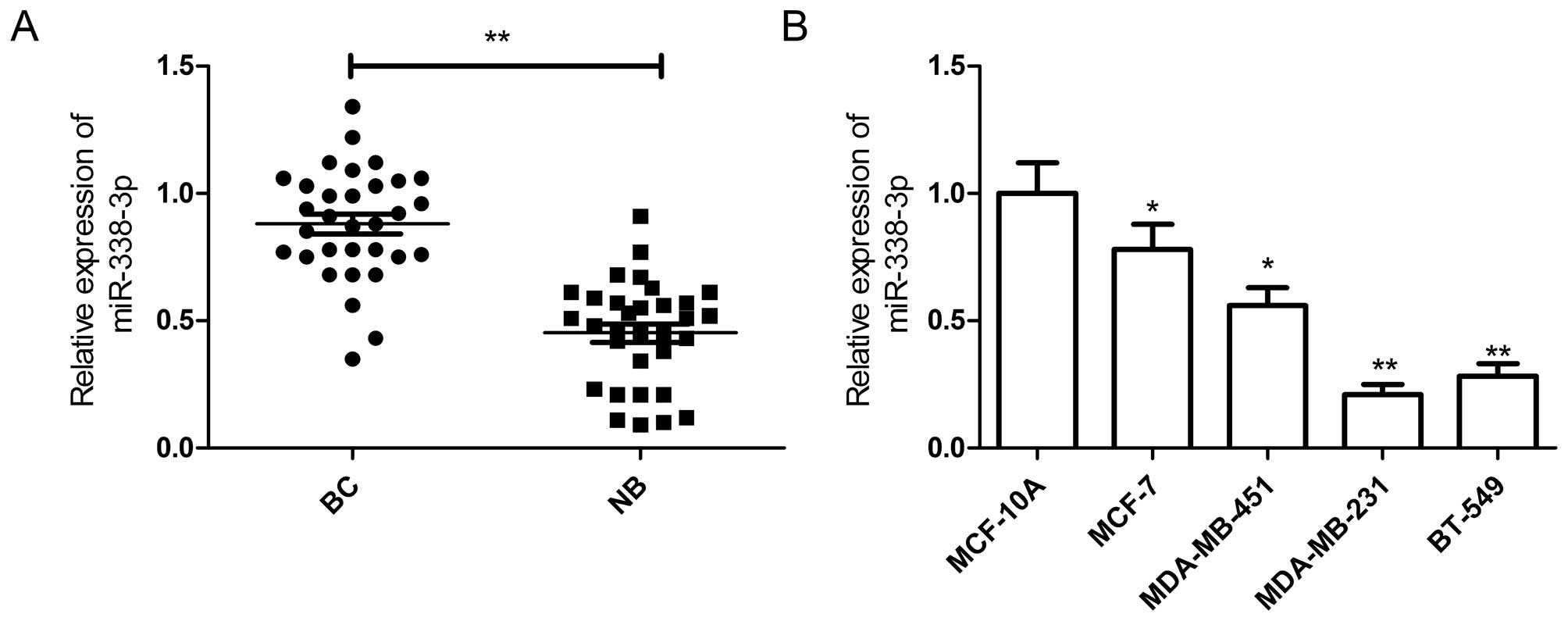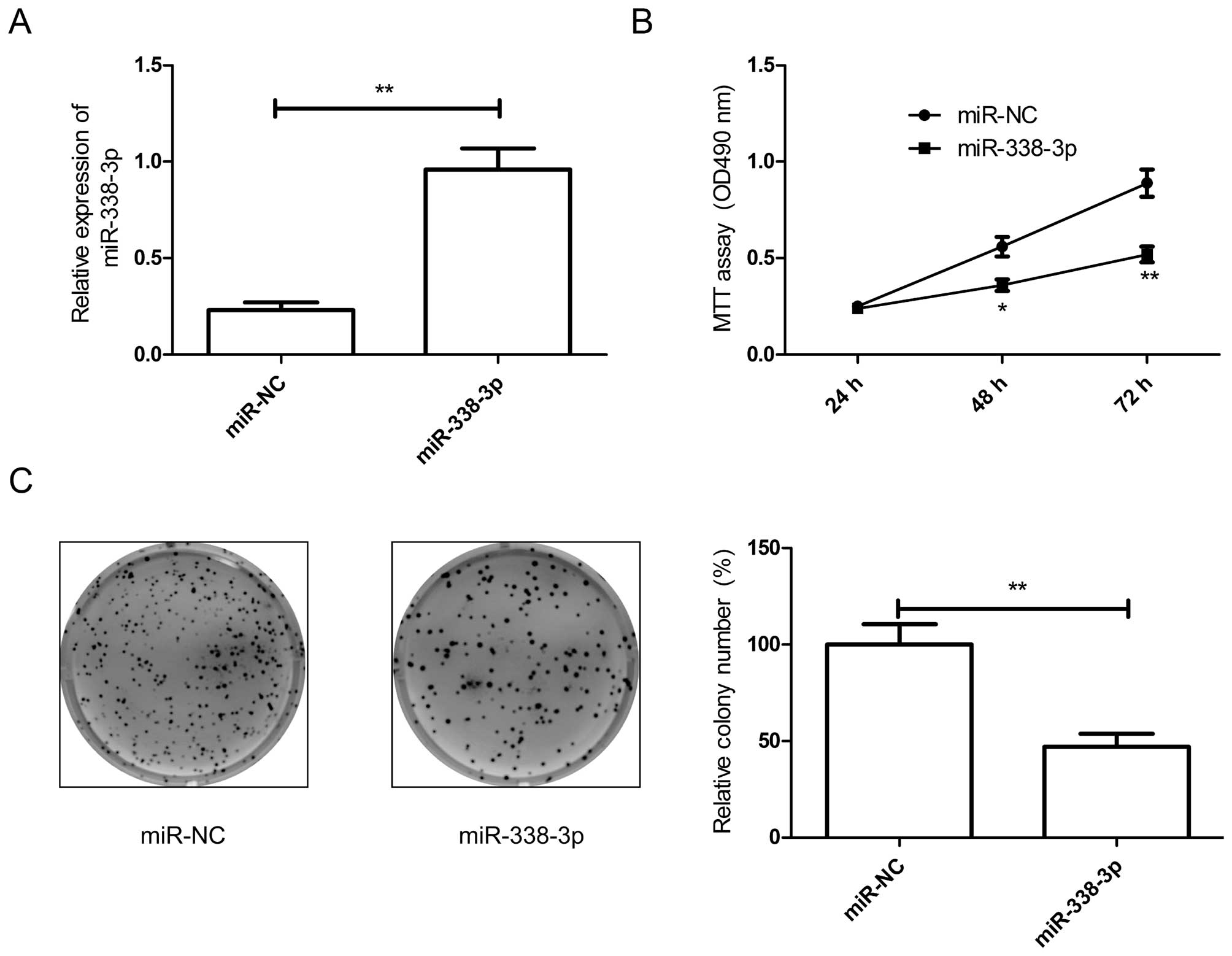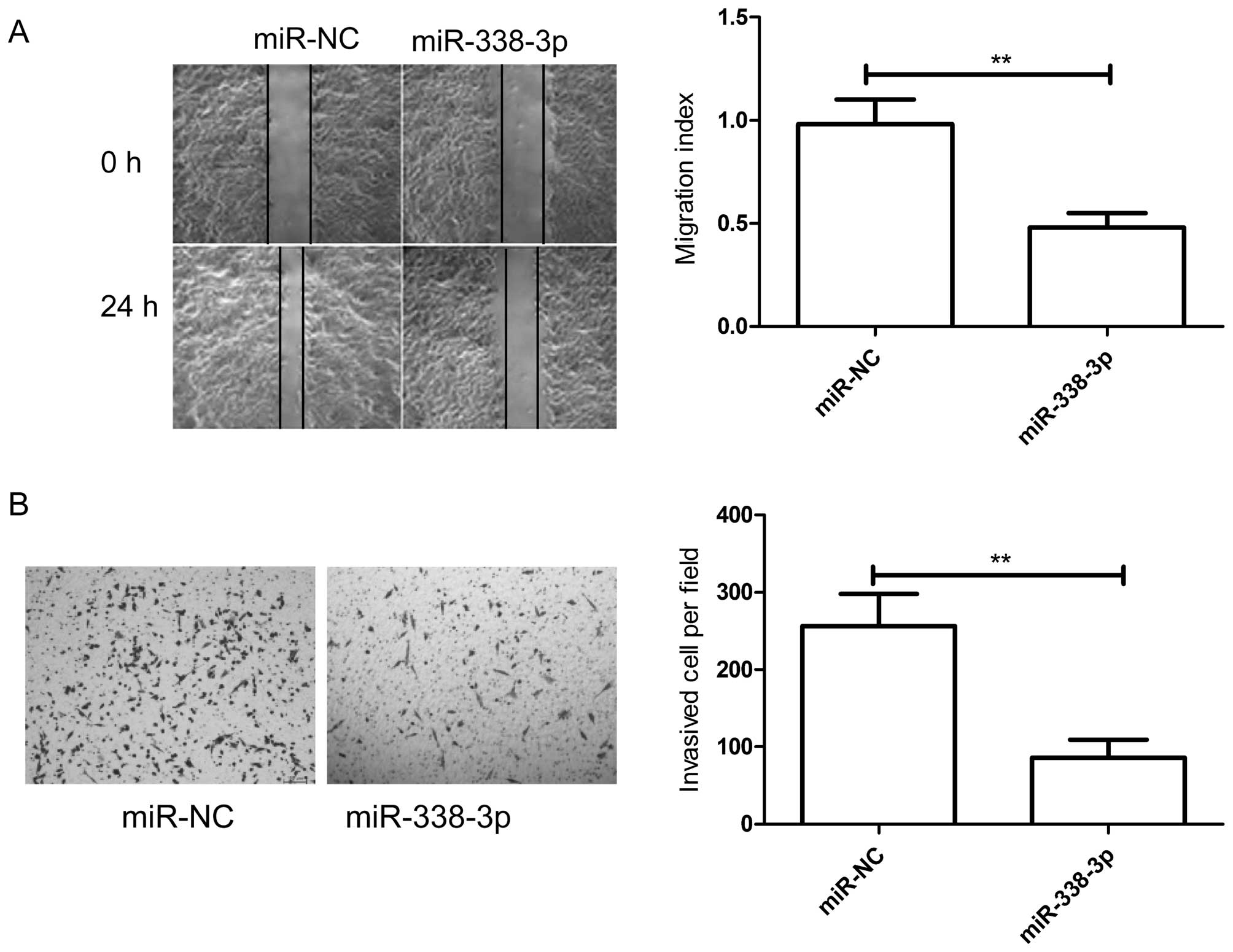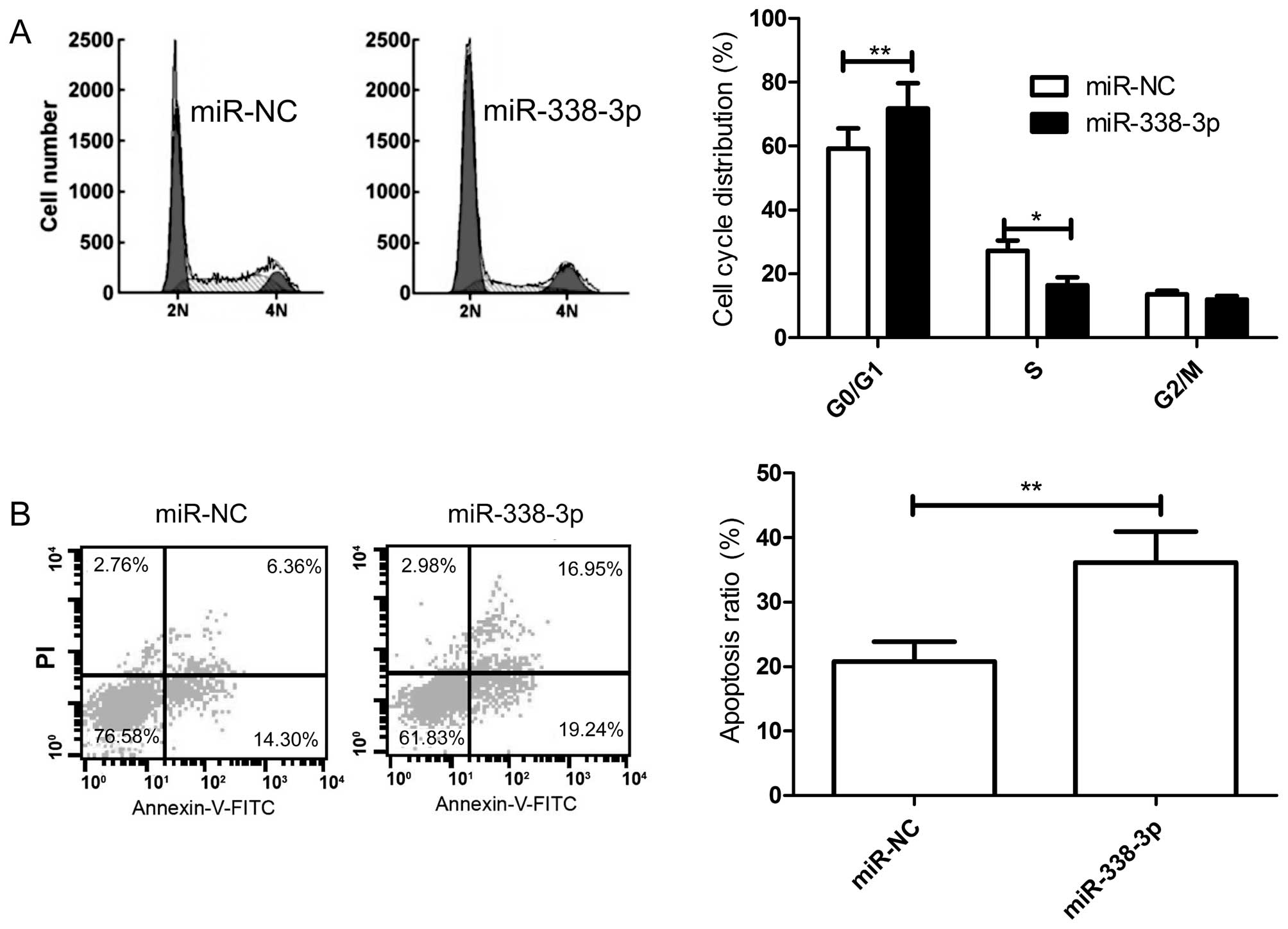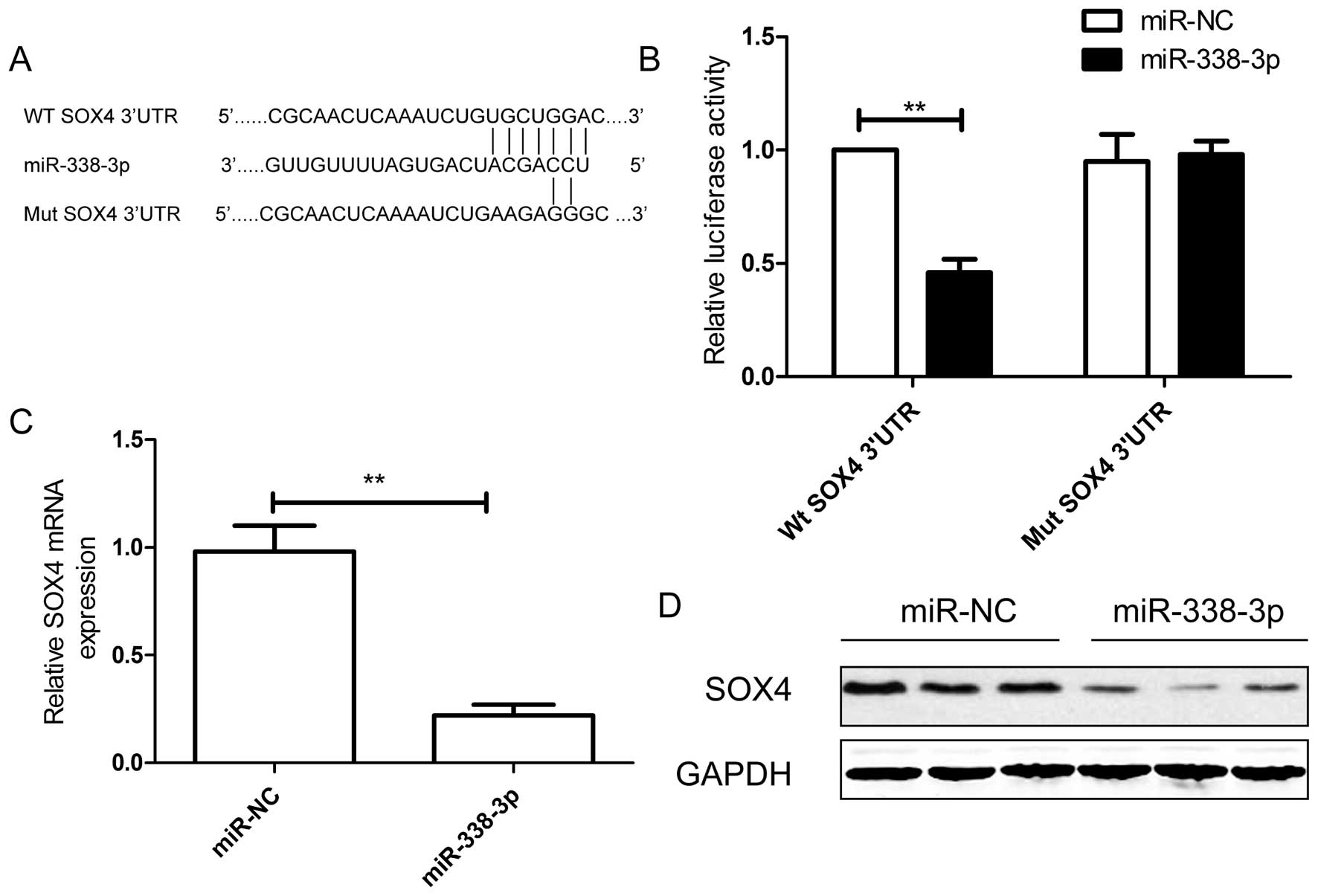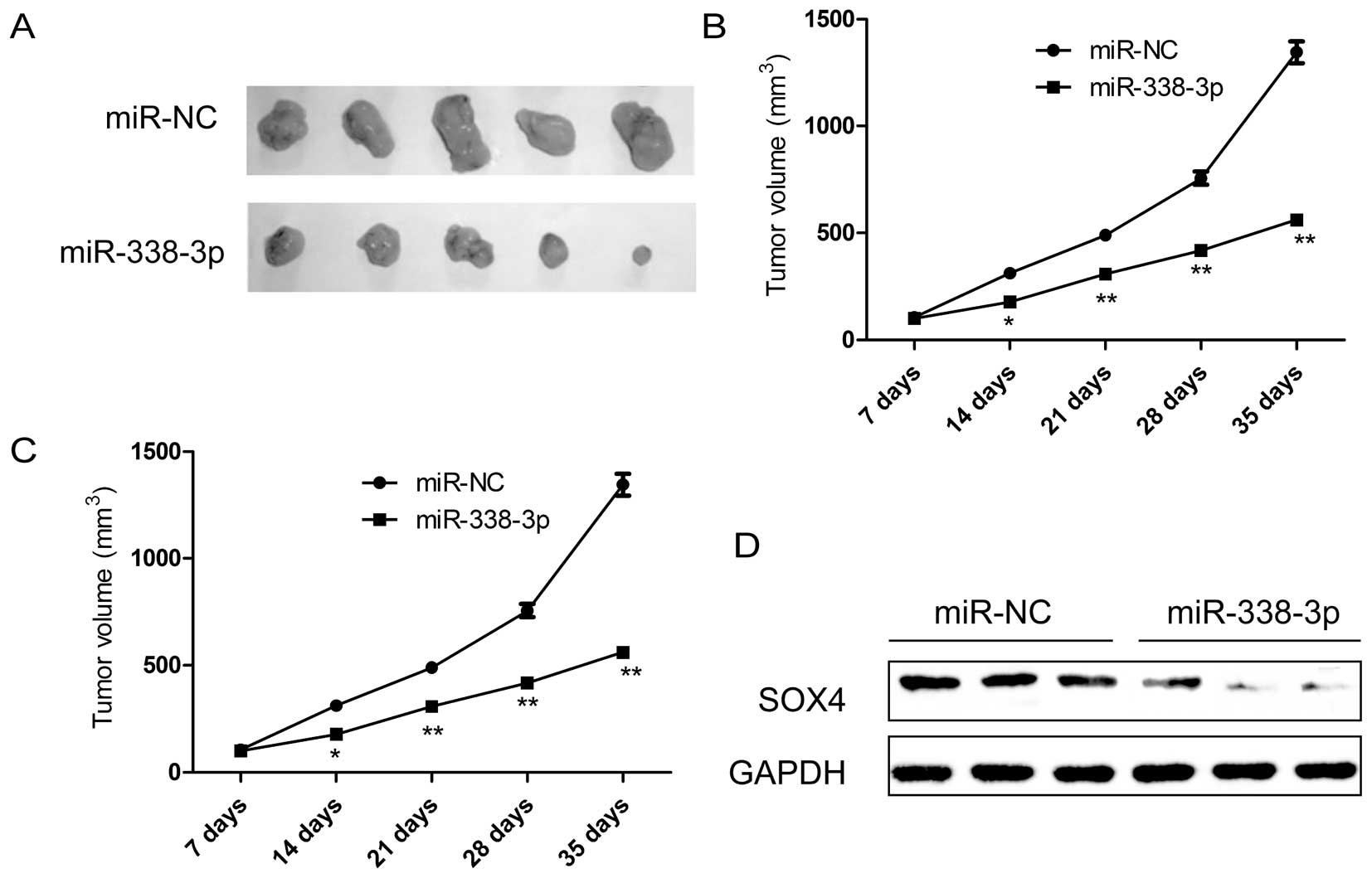MicroRNA-338-3p functions as tumor suppressor in breast cancer by targeting SOX4
Retraction in: /10.3892/ijo.2024.5609
- Authors:
- Published online on: August 6, 2015 https://doi.org/10.3892/ijo.2015.3114
- Pages: 1594-1602
Abstract
Introduction
Breast cancer (BC) is one of the most prevalent cancers in women and accounts for ~22.9% of all cancers in women worldwide (1). BC also is the second most prevalent malignancy and the fifth most common cause of cancer death worldwide (1). In China, breast cancer is one of the most common cancers in women, and its incidence has increased by 3% annually (2). The tumorigenesis process of BC is complicated involving many genetic and molecular alterations (3). Although many researchers have demonstrated signal pathways involved in BC initiation and procession, understanding the mechanism underlying the development of BC is challenging. Therefore, better understanding of the molecular mechanisms underlying BC development and progression is urgently needed.
MicroRNAs (miRNAs) are a group of endogenous smallnon-coding RNAs that regulate the expression of their target genes post-transcriptionally, by directly binding to the untranslated region or the open reading frame and thus inducing RNA degradation or the inhibition of protein translation (4,5). Recent evidence strongly supports the finding that miRNAs participate in the regulation of many cellular processes, including development, differentiation, apoptosis, and proliferation (6). Growing evidence indicated that miRNAs are aberrantly expressed in different types of tumors (7) and involved in human tumorigenesis and/or metastasis by directly targeting oncogenes or tumor suppressor genes (8). Many miRNAs have been confirmed as modulators of cell proliferation, apoptosis, and therapy resistance in BC (9–12). Therefore, more extensive investigations are needed on the role of miRNAs, which would contribute to develop novel avenues for targeted therapy.
Recently, the expression pattern and function of the miR-338-3p was widely studied in various cancers, and reported to function as a tumor suppressor gene in various cancer, including hepatocellular carcinoma (13,14), neuroblastoma (15), ovarian cancer (16), malignant melanoma (17), gastric cancer (18,19) and colorectal cancer (20,21). However, to our knowledge, its roles and the potential mechanisms in BC remain unclear. Hence, our study was aimed to identify the role of miR-338-3p in BC. We found that the expression of miR-338-3p was suppressed in both BC tissues and cancer cell lines. Furthermore, the low expression of miR-338-3p was associated with late TNM stage and lymph node metastatic status. In addition, overexpression of miR-338-3p in BC cells inhibited cell proliferation, colony formation, migration and invasion, induce apoptosis and cell cycle arrest at G1/G0 stage in vitro, and suppressed tumor growth in vivo by targeting SOX4, which was identified as a direct and functional target of miR-338-3p.
Materials and methods
Patients and tissue samples
Breast cancer samples and the corresponding adjacent ovarian tissues were obtained from 32 patients with primary BC who underwent surgery at China-Japan Union Hospital of Jilin University (Changchun, China) from July 2012 to August 2014. Normal breast tissues adjacent to the tumor were taken from 3 cm away from the tumor cells. All of the samples and matched clinical information were collected after obtaining prior written informed consent from the patients. The samples were immediately snap-frozen in liquid nitrogen and stored at −80°C until use. No patients received chemotherapy or radiotherapy prior to surgery. This study is approved by Institutional Ethics Committees of Jilin University.
Cell lines and cell culture
The non-cancerous human mammary epithelial cell line MCF-10A, breast cancer cell line and human breast cancer cell lines MCF-7, MDA-MB-231, BT-549 and MDA-MB-453 were obtained from the Institute of Biochemistry and Cell Biology, Chinese Academy of Sciences (Shanghai, China). All cells were maintained in RPMI-1640 medium (Gibco, Grand Island, NY, USA) containing 10% fetal bovine serum (FBS, Gibco BRL, Gaithersburg, MD, USA), 100 U/ml penicillin and 100 mg/ml streptomycin at 37°C in a humidified chamber supplemented with 5% CO2.
Quantitative reverse transcription polymerase chain reaction (qRT-PCR)
Total RNA was extracted from tissue and cells using TRIzol (Invitrogen) according to the manufacturer's instructions. For miRNA reverse transcription, cDNA was synthesized using One Step Prime script miRNA cDNA Synthesis kit (Qiagen, Valencia, CA, USA) according to the manufacturer's instructions. For mRNA reverse transcription, cDNA was synthesized using the Primer Script RT reagent kit (Takara Bio, Japan). Quantitative PCR was performed using Fast SYBR Green Master Mix (Applied Biosystems, Foster City, CA, USA) under ABI 7900 Sequence Detection System (Life Technologies, NY, USA). U6 snRNA and GAPDH was used as an endogenous control. The specific primers for miRNA-126 and U6 were purchased from Applied Biosystems. The specific primers for GAPDH and SOX4 are as follows: GAPDH (sense), 5′-TCAACGACCACTTTGTCAAGCTCA-3′; antisense: 5′-GCTGGTGGTCCAGGGGTCTTACT-3′; SOX4 (sense), 5′-AGCGACAAGATCCCTTTCATTC-3′; antisense: 5′-CGTTGCCGGACTTCACCTT-3′. The comparative 2−ΔΔCt method was used for relative quantification and statistical analysis. All experiments were performed in triplicate.
Transient transfection of miRNA mimics
miRNA-338-3p mimics and negative control mimics (miR-NC) were purchased from GenePharma (Shanghai, China). MDA-MB-231 cells were seeded into cell culture plates 20 h before transfection to ensure 70% cell confluence at the moment of transfection. Transfection of miRNA mimics into MDA-MB-231 cells was performed using Lipofectamine 2000 (Invitrogen) according to the manufacturer's procedure at the final concentration of 100 nM. At 48 h post-transfection, transfection efficiencies were evaluated in every experiment by qRT-PCR and western blot analysis.
Cell proliferation (MTT) assay and colony formation assay
The transfected cells (5×103 cells/well) were plated into 96-well plates. At 24, 48 and 72 h post-transfection, MTT (3-(4,5-dimethylthiazol-2-yl)-2,5-diphenyltetrazolium bromide) were added into cells and cultured for 4 h at 37°C, followed by removal of the culture medium and the addition of 150 μl dimethyl sulfoxide (DMSO, Sigma-Aldrich). The absorbance at 490 nm (OD490 nm) was measured with a spec-trophometer.
For colony formation, the transfected cells were seeded into a 6-well plate at a density of 1,000 cells/well. The medium was changed every three days. Approximately 2 weeks later, the clones were washed with 1X PBS and stained with 1.0% crystal violet (Sigma) for 5 min. Finally the clones were photographed and counted.
Cell cycle and apoptosis assay
Cell cycle and apoptosis assay was performed on MDA-MB-231 cells 48 h after transfection. For cell cycle assay, the transfected cells at 1×106 cells per well were cultured in 12-well plates in triplicate and cultured for 24 h. Then the cells were collected by trypsinization and washed in PBS and fixed in ice-cold ethanol overnight at 4°C, followed by incubated in 1 ml of staining solution (20 μg/ml propidium iodide and 10 U/ml RNaseA) for 30 min at room temperature. Cell cycle distribution was assayed by fluorescence-activated cell sorting based on FACSCalibur flow cytometer (BD Biosciences, San Jose, CA, USA). All experiments were performed in triplicate.
Cell apoptosis analysis was performed with Annexin V-FITC Apoptosis Detection kit I (BD Biosciences) according to the manufacturer's instructions using FACSCalibur flow cytometer (BD Biosciences).
Wound healing assay
Transfected cells (5×103) were seeded into 24-well tissue culture plates for 48 h. Thereafter, a linear wound of cellular monolayer was created in the confluent cells. After wounding, the debris was removed by washing the cells with PBS. Migration of cells into the wound was observed at 0 and 24 h using an IX51 inverted microscope (Olympus, Tokyo, Japan). Individual cells were quantified as an average of at least five fields for each experiment.
Cell invasion assay
Cell invasion assays were performed using 24-well Transwell Permeable Supports with 8-μM pores (Corning, Lowell, MA, USA). Briefly, 2×104 transfected cells were suspended in serum-free medium and seeded into the Transwell inserts coated with growth factor reduced Matrigel (BD Biosciences, Bedford, MA, USA). Bottom wells were filled with media containing complete media. The invasion assay was performed for 24 h at 37°C in a 5% CO2 incubator. After incubation, migrating cells present on the lower surface of the membrane were fixed in 70% ethanol for 30 min and stained with 2% crystal violet for 10 min on a glass slide. Cells from 10 random fields were counted under an IX51 inverted microscope (Olympus).
miRNA target prediction
Prediction of the miR-338-3p targets was performed using two publicly available algorithms: TargetScan6.2 (http://www.targetscan.org/), miRanda (http://www.microrna.org/).
Assay of luciferase activity
The 3′-UTR of SOX4 was amplified and cloned downstream of pGL3/Luciferase vector (Wt SOX4 3′-UTR). Then the mutant 3′-UTR of SOX4 (several nucleotides within the binding sites were mutanted) was amplified using pGL3/Luc-SOX4 3′-UTR as the template, and was cloned downstream of the pGL3/Luciferase vector (Mut SOX4 3′-UTR). For the luciferase reporter assay, the cells were co-transfected with miR-338-3p mimic or miR-NC and Wt SOX4 3′-UTR or Mut SOX4 3′-UTR, together with the controls. Forty-eight hours post-transfection, cells were lysed using 1X passive lysis buffer (Promega, Madison, WI, USA) and lysates were analyzed using the Dual-Glo Luciferase Reporter Assay System (Promega) on the Synergy4 multi-mode microplate reader (BioTeK).
Western blot analysis
Total protein was extracted by using RIPA buffer (Santa Cruz Biotechnology, Inc., Santa Cruz, CA, USA) from cells harvested 48 h after transfection, separated in 10% SDS polyacrylamide gels, and electrophoretically transferred to nitrocellulose membranes (NC membranes, Invitrogen, Carlsbad, CA, USA), blocked in 4% dry milk at room temperature for 1 h, and immunostained with primary antibodies at 4°C overnight using anti-SOX4 (1:1,000, Santa Cruz); and anti-GAPDH antibody (1;5,000, Santa Cruz). After washing, membranes were incubated with horseradish peroxidase (HRP)-conjugated goat anti-mouse secondary antibodies (1:5,000; Santa Cruz Biotechnology). The protein bands were visualized on X-ray film with a chemiluminescent detection system (Beyotime, Shanghai, China). Blots were stripped and reprobed with anti-GAPDH to control for loading variations.
Nude mouse xenograft assay
Twenty female BALB/c mice (18–20-g, 4–5-week-old) were obtained from Experimental Animal Center of Changchun Biological Institute (Changchun, China), and kept under specific pathogen-free (SPF) conditions. This study and all experimental protocols were approved and the methods were performed in accordance with the guidelines of the Animal Care and Use Committee of Jilin University.
MDA-MB-231 cells (2×106), stably expressing miR-338-3p or miR-NC, were suspended in 100 μl PBS and then injected subcutaneously into the posterior flank of female BALB/c athymic nude mice. Tumor volumes in mice were measured with a slide caliper every week until scarifice according to the formula: Volume (mm3) = 1/2 × width2 × length. Five weeks after injection, mice were sacrificed, and tumor tissues were resected and weighed. In addition, SOX4 protein expression level of tumor tissue was determined by western blot analysis.
Statistical analysis
All the data are shown as mean ± SD (standard deviation) and the experiments were repeated three times. The difference was determined by two-tailed Student's t-test. Statistical analysis was performed with GraphPad Prism 5.0 (GraphPad Software, San Diego, CA, USA). P<0.05 was considered statistically significant.
Results
miR-338-3p is downregulated in breast cancer tissues and cell lines
To determine the role of miR-338-3p in breast cancer progression, we examined miR-338-3p expression in breast cancer tissue samples and corresponding normal tissue sample by qRT-PCR. miR-338-3p was downregulated in the breast cancer samples compared with the paired normal breast tissues (Fig. 1A). To investigate the clinical relevance of miR-338-3p in breast cancer, we divided the 32 patients to high miR-338-3p expression group (n=17) and low miR-338-3p expression group (n=15) using the mean value (0.45±0.04) of relative expression levels as a cutoff. The correlation between the miR-338-3p expression level and clinical and pathologic characteristics of breast cancer is listed in Table 1. In 12 cases presenting as advanced stage III, 9 (75.0%) of the cases have low-level miR-338-3p expression in cancer tissues; while in 20 early stages (stages I and II), only 6 (30.0%) presented with low levels of miR-338-3p expression. In the 13 cases of breast cancer patients with lymph node metastasis, 10 (76.9%) exhibited low miR-338-3p expression, however only 5 (26.3%) of 19 cases of cancers without lymph node metastasis presented low-level miR-338-3p expression. No correlation was observed between the miR-338-3p level and the age, tumor size or pathologic grade status of breast cancer.
Table ICorrelation between clinicopathological features and miR-338-3p expression in 32 breast cancer tissues. |
In addition, the expression of miR-338-3p was detected in a panel of breast cancer cell lines and non-cancerous breast epithelial cell line (MCF-10A). It was found that miR-338-3p expression was downregulated in breast cancer cell lines compared to normal non-cancerous breast epithelial cell line MCF-10A (Fig. 1B). The data above showed that miR-338-3p decreases in both breast cancer tissues and cell lines, and that its expression is inversely correlated with the metastatic abilities of breast cancer cells. We selected MDA-MB-231 cells, which showed the lowest expression of miR-338-3p, to conduct further experiments.
Overexpression of miR-338-3p inhibits cell proliferation and colony formation of breast cancers
As miR-338-3p was downregulated in breast cancer tissues and cell lines, we transfected miR-338-3p mimic into breast cancer cells. The results from qRT-PCR assay showed that miR-338-3p mimic could significantly upregulate the level of miR-338-3p expression in breast cancer cells compared to miR-NC group (Fig. 2A). To confirm miR-338-3p effect on proliferation and colony formation in breast cancer cells, MTT assay and colony formation assay were performed. It was found that overexpression of miR-338-3p significantly inhibited cell proliferation (Fig. 2B) and colony formation (Fig. 2C) in breast cancer cells.
Overexpression of miR-338-3p inhibits cell migration and invasion of breast cancers
The above results showed that miR-338-3p expression is inversely correlated with the meta-static ability of breast cancer cells, therefore, to investigate the miR-338-3p effect on metastasis in vitro, migration and invasion assays were performed in MDA-MB-231 cells transfected with miR-338-3p mimic or miR-NC by wound healing and transwell chamber assay, respectively. As expected, overexpression of miR-338-3p in breast cancer cells significantly inhibited cell migration (Fig. 3A) and invasion (Fig. 3B) of breast cancer cells. Collectively, these results suggested that miR-338-3p can efficiently inhibited migration and invasion of breast cancer cells.
Overexpression of miR-338-3p induces cell cycle arrest at G1/G0 stage and apoptosis of breast cancers
To further verify the role of miR-338-3p in breast cancer cells, we tested the cell cycle and apoptosis effects in breast cancer cells by flow cytometry. Cell cycle assay showed that the percentage of G1 phase cells increased, and the percentage of S phase cells decreased in breast cancer cells transfected with miR-338-3p mimic compared to cells transfected with miR-NC (Fig. 4A). Cell apoptosis assay showed that overexpression of miR-338-3p significantly induced cell apoptosis in breast cancer cells (Fig. 4B).
SOX4 is a direct target of miR-338-3p
To explore the mechanism underlying the growth inhibition by miR-338-3p in breast cancer cells, we used publicly available algorithms (Targetscan6.2 and miRanda) to help identify miR-338-3p targets in human breast cancer. We found that sex-determining region Y-box 4 (SOX4) was a putative target of miR-338-3p. To confirm this possibility, the miR-338-3p binding sequences present at the 3′-UTR of SOX4 mRNA (WT-3′-UTR SOX4) or its mutant site (Mut-3′-UTR-SOX4) were subcloned downstream of the luciferase reporter gene in pGL3 vector (Fig. 5A) and then co-transfected into MDA-MB-231 cells, along with miR-338-3p mimic or miR-NC for luciferase assay evaluation. Luciferase assay further revealed that breast cancer cells transfected with miR-338-3p mimic repressed wild-type 3′-UTR-SOX4 reporter activity (P<0.01), while miR-338-3p mimic had no inhibition effect on the mutant 3′-UTR-SOX4 reporter activity (Fig. 5B), indicting the direct regulation of miR-338-3p in the 3′-UTR of SOX4 mRNA. To further confirm that SOX4 acts as a target of miR-338-3p, we examine the effect of miR-338-3p on SOX4 expression by qRT-PCR and western blot analysis. As predicted, qRT-PCR and western blotting showed that ectopic miR-338-3p in BC cells downregulated SOX4 expression on mRNA level (Fig. 5C) and protein level (Fig. 5D).
SOX4 is upregulated in BC tissues and is inversely correlated with miR-338-3p levels
As the above results show that miR-338-3p is downregulated in BC and targets SOX4 by binding to its 3′-UTR, we next determined whether SOX4 expression is negatively associated with miR-338-3p levels in the BC tissue samples. qRT-PCR and western blot assay showed that the expression of SOX4 on mRNA and protein level was significantly higher in BC tissues than in matched normal tissues (P<0.05) (Fig. 6A and B). In addition, a statistically significant inverse correlation was found between expression levels of miR-338-3p and SOX4 mRNA in BC tissue by Spearman's correlation analysis (r=−0.6431, P<0.001, Fig. 6C).
miR-338-3p inhibits tumorigenicity in vivo
Finally, we tested whether ectopic expression of miR-338-3p could influence the growth of breast tumor in vivo. MDA-MB-231 cells with stable expression either of miR-338-3p or miR-NC were selected and injected subcutaneously into nude mice, and the tumor formation was monitored. MDA-MB-231 cells transfected with miR-NC showed progressive growth, while MDA-MB-231 cells transfected with miR-338-3p mimic inhibited tumor growth relative to miR-NC group. After 35 days, the nude mice were sacrificed, and the tumor weights and volume were measured (Fig. 7A–C). It was found that overexpression of miR-338-3p can significantly suppress the tumor growth of xenografts in nude mice (Fig. 7A), and decrease the tumor volume (Fig. 7B) and tumor weight (Fig. 7C) compared to miR-NC group, indicating the suppressive function of miR-338-3p on breast cancer tumorigenicity in vivo. In addition, we also determined SOX4 protein expression in tumor tissue by western blot analysis. We found that SOX4 protein expression was decreased in the xenograft tumors of miR-338-3p mimic group compared to the xenograft tumors of miR-NC group (Fig. 7D), suggesting that miR-338-3p suppressed breast cancer tumorigenicity in vivo by targeting SOX4.
Discussion
Breast cancer is one of the most commonly diagnosed solid malignancies and the leading cause of cancer-related deaths among women (1). Although great progress in surgical technique, diagnostic methods, and new chemotherapy regimens, have significantly reduced breast cancer-related mortality, nearly half of breast cancer patients develop distant metastatic disease after treatment with chemotherapeutic and/or hormonal drugs (2). Thus, there is an urgent need to understand the molecular mechanism of breast cancer development and metastasis for effective therapy. During the past years, microRNAs (miRNAs) have emerged as promising prognostic and therapeutic targets for metastatic breast cancers (22–24). Lin et al (25) reported that ectopic overexpression of miR-33b in highly metastatic breast cancer cells suppresses cell self-renewal, migration and invasion in vitro and inhibits lung metastasis in vivo by targeting HMGA2, SALL4 and Twist1. Ahmad et al (26) found that miR-20b expression was significantly higher in brain metastases of breast cancer patients, compared to primary breast tumors as well as the patients without brain metastasis, and that miR-20b significantly induced the colony formation and invasiveness of breast cancer cells. Li et al (27) found that ectopic expression of miR-153 could significantly inhibit tumor growth and impair the migration and invasion of breast cancer cells by regulating ETM targeting metadherin (MTDH).
In the present study, to our knowledge, we first report that miR-338-3p was downregulated in breast tumor samples from patients compared with adjacent normal breast tissues. miR-338-3p expression was inversely correlated with clinical stages and metastatic status of breast cancer. Moreover, overexpression of miR-338-3p in breast cancer cells inhibited cell proliferation and migration and invasion in vitro and suppressed tumor growth in vivo. These findings suggested that miR-338-3p may exert tumor-suppressive functions and impede breast tumor growth and metastasis.
Accumulating evidence firmly demonstrates that miRNAs control various key cellular processes such as proliferation, apoptosis, differentiation, metastasis, play important roles in carcinogenesis and tumor progression functioning as oncogene or tumor suppressor gene (28). miR-338-3p, a recently discovered miRNA, functions as tumor suppressor in a wide range of human malignances, including hepatocellular carcinoma, neuroblastoma, ovarian cancer, malignant melanoma, gastric cancer and colorectal cancer (13–21). Previously, the role of miR-338-3p in breast cancer was poorly explored. In agreement with the above study, we found that the overexpression of miR-338-3p in breast cancer cells significantly inhibited cell proliferation, colony formation, migration and invasion, and induced cell apoptosis and cell cycle arrest at G1/G0 stage, as well as suppressed tumor growth of breast cancer in a nude mouse model. Together with our results, these data suggest that miR-338-3p may have potential to serve as a tumor suppressor miRNA in various cancers including breast cancer.
In view of the vital importance of miR-338-3p, we further explored the molecular mechanisms underlying breast cancer cell biological behavior by the regulation of miR-338-3p. We selected TargetScan and miRanda algorithm to search for putative protein-coding gene targets of miR-338-3p, especially for those that have the ability to promote tumor cell proliferation, migration and invasion. Based on this rationale, SOX4 was selected as the potential target for further validation, since it has been shown that deregulated expression of SOX4 is correlated with increased cancer cell proliferation, cell survival, inhibition of apoptosis and tumor progression (29,30).
Sex-determining region Y-box 4 (SOX4), located at chromosome 6p22.3, is a member of the highly conserved SoxC (SRY-related high-motility group box) transcription factor family, which contains two other members, SOX11 and SOX12 (31). Notably, SOX4 has been recognized as one of the 64 cancer signature genes (29,30). Indeed, it is overexpressed in several types of cancer including breast cancer (32). Genome-wide chromatin immunoprecipitation studies have uncovered that SOX4 regulates the transcription of genes involved in TGF-β, Wnt, Hedgehog, and Notch pathways and components of miRNA processing machinery including Dicer, Argonaute 1 and RNA Helicase A (33,34). More recently it was shown that SOX4 induces EMT via the polycomb epigenetic regulator EZH2 (35). Importantly, SOX4 has been found to be regulated by several miRNAs such as miR-335 (36), miR-31 (37), miR-129 family (38), miR-212 (39) and miR-138 (40). Here, we first confirmed that SOX4 is a target of miR-338-3p by luciferase assay, and that upregulation of miR-338-3p decreased the expression of SOX4 on mRNA level and protein level. Our results also showed that SOX4 expression is upregulated in breast cancer tissue, and that high SOX4 expression was associated with low miR-338-3p levels in breast cancer. These finding might suggest that miR-338-3p inhibited breast cancer growth and metastasis by targeting SOX4.
In conclusion, the present study demonstrated that miR-338-3p expression is downregulated in breast tumor samples and breast cancer cell lines and is inversely correlated with TNM stage and lymph node metastatic status. miR-338 functions as tumor suppressor, block breast cancer cell growth and metastasis in vitro and in vivo by targeting SOX4. These finding suggested that miR-338-3p may serve as a new diagnostic and therapeutical agent for breast cancer.
Acknowledgements
This study was supported by the Health Department of Jilin Province (2010SO20).
References
|
DeSantis C, Ma J, Bryan L and Jemal A: Breast cancer statistics, 2013. CA Cancer J Clin. 64:52–62. 2014. View Article : Google Scholar | |
|
Hong W and Dong E: The past, present and future of breast cancer research in China. Cancer Lett. 351:1–5. 2014. View Article : Google Scholar : PubMed/NCBI | |
|
Berse B and Lynch JA: Molecular diagnostic testing in breast cancer. Semin Oncol Nurs. 31:108–121. 2015. View Article : Google Scholar : PubMed/NCBI | |
|
Fabian MR, Sonenberg N and Filipowicz W: Regulation of mRNA translation and stability by microRNAs. Annu Rev Biochem. 79:351–379. 2010. View Article : Google Scholar : PubMed/NCBI | |
|
Guo H, Ingolia NT, Weissman JS and Bartel DP: Mammalian microRNAs predominantly act to decrease target mRNA levels. Nature. 466:835–840. 2010. View Article : Google Scholar : PubMed/NCBI | |
|
Bartel DP: MicroRNAs: Genomics, biogenesis, mechanism, and function. Cell. 116:281–297. 2004. View Article : Google Scholar : PubMed/NCBI | |
|
McManus MT: MicroRNAs and cancer. Semin Cancer Biol. 13:253–258. 2003. View Article : Google Scholar : PubMed/NCBI | |
|
Farazi TA, Spitzer JI, Morozov P and Tuschl T: miRNAs in human cancer. J Pathol. 223:102–115. 2011. View Article : Google Scholar : | |
|
Tang J, Ahmad A and Sarkar FH: The role of microRNAs in breast cancer migration, invasion and metastasis. Int J Mol Sci. 13:13414–13437. 2012. View Article : Google Scholar : PubMed/NCBI | |
|
Christodoulatos GS and Dalamaga M: Micro-RNAs as clinical biomarkers and therapeutic targets in breast cancer: Quo vadis? World J Clin Oncol. 5:71–81. 2014. View Article : Google Scholar : PubMed/NCBI | |
|
Schrauder MG, Strick R, Schulz-Wendtland R, Strissel PL, Kahmann L, Loehberg CR, Lux MP, Jud SM, Hartmann A, Hein A, et al: Circulating micro-RNAs as potential blood-based markers for early stage breast cancer detection. PLoS One. 7:e297702012. View Article : Google Scholar : PubMed/NCBI | |
|
Le Quesne J and Caldas C: Micro-RNAs and breast cancer. Mol Oncol. 4:230–241. 2010. View Article : Google Scholar : PubMed/NCBI | |
|
Huang XH, Chen JS, Wang Q, Chen XL, Wen L, Chen LZ, Bi J, Zhang LJ, Su Q and Zeng WT: miR-338–3p suppresses invasion of liver cancer cell by targeting smoothened. J Pathol. 225:463–472. 2011. View Article : Google Scholar : PubMed/NCBI | |
|
Fu X, Tan D, Hou Z, Hu Z, Liu G, Ouyang Y and Liu F: The effect of miR-338-3p on HBx deletion-mutant (HBx-d382) mediated liver-cell proliferation through CyclinD1 regulation. PLoS One. 7:e432042012. View Article : Google Scholar : PubMed/NCBI | |
|
Chen X, Pan M, Han L, Lu H, Hao X and Dong Q: miR-338-3p suppresses neuroblastoma proliferation, invasion and migration through targeting PREX2a. FEBS Lett. 587:3729–3737. 2013. View Article : Google Scholar : PubMed/NCBI | |
|
Wen C, Liu X, Ma H, Zhang W and Li H: miR-338-3p suppresses tumor growth of ovarian epithelial carcinoma by targeting Runx2. Int J Oncol. 46:2277–2285. 2015.PubMed/NCBI | |
|
Caramuta S, Egyházi S, Rodolfo M, Witten D, Hansson J, Larsson C and Lui WO: MicroRNA expression profiles associated with mutational status and survival in malignant melanoma. J Invest Dermatol. 130:2062–2070. 2010. View Article : Google Scholar : PubMed/NCBI | |
|
Li P, Chen X, Su L, Li C, Zhi Q, Yu B, Sheng H, Wang J, Feng R, Cai Q, et al: Epigenetic silencing of miR-338-3p contributes to tumorigenicity in gastric cancer by targeting SSX2IP. PLoS One. 8:e667822013. View Article : Google Scholar : PubMed/NCBI | |
|
Guo B, Liu L, Yao J, Ma R, Chang D, Li Z, Song T and Huang C: miR-338-3p suppresses gastric cancer progression through a PTEN-AKT axis by targeting P-REX2a. Mol Cancer Res. 12:313–321. 2014. View Article : Google Scholar : PubMed/NCBI | |
|
Sun K, Su G, Deng H, Dong J, Lei S and Li G: Relationship between miRNA-338-3p expression and progression and prognosis of human colorectal carcinoma. Chin Med J (Engl). 127:1884–1890. 2014. | |
|
Sun K, Deng HJ, Lei ST, Dong JQ and Li GX: miRNA-338-3p suppresses cell growth of human colorectal carcinoma by targeting smoothened. World J Gastroenterol. 19:2197–2207. 2013. View Article : Google Scholar : PubMed/NCBI | |
|
Wang L and Wang J: MicroRNA-mediated breast cancer metastasis: From primary site to distant organs. Oncogene. 31:2499–2511. 2012. View Article : Google Scholar | |
|
Kusama M, Kaise H, Nakayama S, Ohta D, Aoki T and Koyanagi Y: A case of breast cancer patient of CAF (cyclophosphamide, adriamycin, 5-fluorouracil) resistant lung metastasis with remarkable response to reverse drug-resistance by toremifene. Gan To Kagaku Ryoho. 26:1171–1175. 1999.(In Japanese). PubMed/NCBI | |
|
Tang J, Ahmad A and Sarkar FH: The role of microRNAs in breast cancer migration, invasion and metastasis. Int J Mol Sci. 13:13414–13437. 2012. View Article : Google Scholar : PubMed/NCBI | |
|
Lin Y, Liu AY, Fan C, Zheng H, Li Y, Zhang C, Wu S, Yu D, Huang Z, Liu F, et al: MicroRNA-33b inhibits breast cancer metastasis by targeting HMGA2, SALL4 and Twist1. Sci Rep. 5:99952015. View Article : Google Scholar : PubMed/NCBI | |
|
Ahmad A, Ginnebaugh KR, Sethi S, Chen W, Ali R, Mittal S and Sarkar FH: miR-20b is up-regulated in brain metastases from primary breast cancers. Oncotarget. 6:12188–12195. 2015. View Article : Google Scholar : PubMed/NCBI | |
|
Li W, Zhai L, Zhao C and Lv S: MiR-153 inhibits epithelial-mesenchymal transition by targeting metadherin in human breast cancer. Breast Cancer Res Treat. 150:501–509. 2015. View Article : Google Scholar : PubMed/NCBI | |
|
Yi B, Piazza GA, Su X and Xi Y: MicroRNA and cancer chemo-prevention. Cancer Prev Res (Phila). 6:401–409. 2013. View Article : Google Scholar | |
|
Vervoort SJ, Lourenço AR, van Boxtel R and Coffer PJ: SOX4 mediates TGF-β-induced expression of mesenchymal markers during mammary cell epithelial to mesenchymal transition. PLoS One. 8:e532382013. View Article : Google Scholar | |
|
Vervoort SJ, van Boxtel R and Coffer PJ: The role of SRY-related HMG box transcription factor 4 (SOX4) in tumorigenesis and metastasis: Friend or foe? Oncogene. 32:3397–3409. 2013. View Article : Google Scholar | |
|
Bowles J, Schepers G and Koopman P: Phylogeny of the SOX family of developmental transcription factors based on sequence and structural indicators. Dev Biol. 227:239–255. 2000. View Article : Google Scholar : PubMed/NCBI | |
|
Song GD, Sun Y, Shen H and Li W: SOX4 overexpression is a novel biomarker of malignant status and poor prognosis in breast cancer patients. Tumour Biol. Jan 16–2015.(Epub ahead of print] 2015. View Article : Google Scholar | |
|
Rhodes DR, Yu J, Shanker K, Deshpande N, Varambally R, Ghosh D, Barrette T, Pandey A and Chinnaiyan AM: Large-scale meta-analysis of cancer microarray data identifies common transcriptional profiles of neoplastic transformation and progression. Proc Natl Acad Sci USA. 101:9309–9314. 2004. View Article : Google Scholar : PubMed/NCBI | |
|
Scharer CD, McCabe CD, Ali-Seyed M, Berger MF, Bulyk ML and Moreno CS: Genome-wide promoter analysis of the SOX4 transcriptional network in prostate cancer cells. Cancer Res. 69:709–717. 2009. View Article : Google Scholar : PubMed/NCBI | |
|
Tiwari N, Tiwari VK, Waldmeier L, Balwierz PJ, Arnold P, Pachkov M, Meyer-Schaller N, Schübeler D, van Nimwegen E and Christofori G: Sox4 is a master regulator of epithelial-mesenchymal transition by controlling Ezh2 expression and epigenetic reprogramming. Cancer Cell. 23:768–783. 2013. View Article : Google Scholar : PubMed/NCBI | |
|
Tavazoie SF, Alarcón C, Oskarsson T, Padua D, Wang Q, Bos PD, Gerald WL and Massagué J: Endogenous human microRNAs that suppress breast cancer metastasis. Nature. 451:147–152. 2008. View Article : Google Scholar : PubMed/NCBI | |
|
Koumangoye RB, Andl T, Taubenslag KJ, Zilberman ST, Taylor CJ, Loomans HA and Andl CD: SOX4 interacts with EZH2 and HDAC3 to suppress microRNA-31 in invasive esophageal cancer cells. Mol Cancer. 14:242015. View Article : Google Scholar : PubMed/NCBI | |
|
Yu X, Song H, Xia T, Han S, Xiao B, Luo L, Xi Y and Guo J: Growth inhibitory effects of three miR-129 family members on gastric cancer. Gene. 532:87–93. 2013. View Article : Google Scholar : PubMed/NCBI | |
|
Luo XJ, Tang DG, Gao TL, Zhang YL, Wang M, Quan ZX and Chen J: MicroRNA-212 inhibits osteosarcoma cells proliferation and invasion by down-regulation of Sox4. Cell Physiol Biochem. 34:2180–2188. 2014. View Article : Google Scholar | |
|
Yeh YM, Chuang CM, Chao KC and Wang LH: MicroRNA-138 suppresses ovarian cancer cell invasion and metastasis by targeting SOX4 and HIF-1α. Int J Cancer. 133:867–878. 2013. View Article : Google Scholar : PubMed/NCBI |



